How to Thrive After COVID-19: Effective Leadership.
Expanding on Webinar, April 22, 2020
Recall the three ideas on how to be an effective leader during times like these:
1. Define the problem.
2. Tell me the story.
3. Give me resiliency.
Let’s focus on define the problem.
How do you define the problem in such a way as to increase revenue and decrease expense – in other words, survive and prosper?
Tell me what to see. When you define the problem, what you are really doing is telling everyone what to see. You are telling them what matters and what to pay attention to. You are telling them “if we can change this, we can change everything”.
That means you must think about what matters, approaching this with the part of your brain that solves math problems. Telling people what to see is telling them what, if changed, will have disproportionate impact on solving all our problems.
How to decide what to do based on what you see is described on my website in the blog entry This or That.
In our story, Inclusion Solutions asked us to see that voting in a pandemic is at risk, and that we can do something about it.
Make it actionable. Defining reality in a way that is actionable is how you create movement towards what you want to happen.
This means using your heart, not your head, because action originates in the heart. This is where you give people the desire – the ‘taste in their mouth’ – that makes them want to do the work.
Think of the counter example. If you are defining reality in a way that is not actionable, you are not defining a problem. You are describing gravity. Gravity is not a problem – it is a circumstance and a fact; there is nothing to do about it.*
In our story, by identifying the problem as voting is not safe in a pandemic, the actions begin to surface. What would make voting safe? What would make poll workers safe? What would reassure both voters and poll workers that voting is safe?
Create energy. By defining reality in a way that is actionable, you create the energy needed to produce the action. Energy sounds amorphous; it is not. People will make sacrifices, take risks, work very hard and then work very hard again when they are seen to be doing so, and when they themselves see that their efforts are positively impacting “reality” (results).
In the story about Inclusion Solutions, imagine the amount of work that had to be done sourcing face masks, hand sanitizer, screen cleaners, gloves – equipment the whole world is looking for at the same time. This work did get done because the company defined the problem as “make it safe to vote” and believed this was a worthy project that customers would pay for.
Define the problem. Try it now.
- Write down in a few sentences your definition of the problem – what you want people in your organization to see.
- Write down in bullet points actions that mitigate the problem. Do not hem yourself in by wondering if the action is enough. What matters is that these actions positively impact the problem you have identified.
- Do you notice an increase in energy as you record suggested actions? If you do, so will those around you.
*Bill Burnett and Dave Evans, two Stanford professors, used this concept in their book Designing Your Life.


